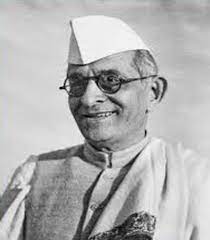
Dr. K M Munshi
Bharatiya Vidya Bhavan is not just an institution; it is a movement, a cause. Its objects have been, from its inception, to encourage the study of all aspects of Indian Culture, to help in the reintegration of the latter in the light of modern conditions; and to aid the fundamentals of Aryan Culture. The Bhavan is thus a centre in which our ancient learning and modern intellectual aspirations combine to create a new spirit and literature a new history and culture.
The Bharatiya Vidya Bhavan was founded by Dr Kanhaiyalal Maneklal Munshi (Popularly known as Munshiji) on 7th November 1938. Munshiji is blessed enough to have Sri Aurobindo as his direct teacher. The Bardoli Satyagraha Movement in 1928 drew Munshiji into the vortex of the Indian independence movement and got attached to Gandhiji and Sardar Patel. If Sri Aurobindo had initiated Munshiji into jnana-yoga, Gandhiji initiated Munshiji into karma-yoga. Munshiji became thereby an example of wisdom through action and action through wisdom.
Dr Munshi initiated Bhavan with a vision to rein post-independent India with the synergy of Indian ancient learning and modern intellectual aspirations. According to him, Bhavan will be a new association which will organise active centres where ancient Aryan learning can be studied and where modern Indian culture will be provided with a historical background.
The first activities of the Bhavan were started on the premises of the Fellowship School on June 1, 1939. Subsequently, they were transferred to rented premises at Andheri. Soon after this, the Department of Jain Studies was opened. With the cooperation of the Gujarati Sahitya Parishad, Shri Narmada Gujarati Shikshapith was formed. On September 1, 1939, the Mumbadevi Sanskrit Pathshala was opened as part of the Bhavan, with the help of the Mumbadevi Trust. In 1940, Shri Nagardas Rughnathdas Jyotish Shikshapith was founded, and the beginnings of a library were made.
In the same year, a land measuring about eleven acres was purchased at Andheri from the Government and the generosity of several friends of the Bhavan. On September 14, 1940, Shri Munshiji laid the foundation stone of the building, which when completed in 1941, was opened by Dr. S. Radhakrishnan.
In January 1947, two of the old buildings were demolished and the foundation stone of the new building was laid by Shri Munshiji on February 23, 1947. The new building was completed in 1949. Constructed on a grand scale keeping in view the growing needs of the Bhavan’s activities, this building took two years and three months to complete and cost over Rs. 18,00,000. This achievement was made possible mainly because of the organising genius and untiring zeal of our Vice-President, Smt. Lilavati Munshi. Shri C. Rajagopalachari, the then Governor-General of India, declared the new building open on August 8, 1949. This Central Home of the Bhavan has proved to be the hub of cultural activity in Bombay. The inauguration in 1951, by Shri Munshiji, of the Bhavan’s Book University and the promotion of the Sanskrit Vishva Parishad (World Academy of Sanskrit) with its head office in the Bhavan have added considerably to the activities of the Bhavan.
On account of its ceaseless efforts in the cause of the cultural renaissance of India, the Bhavan slowly developed into an institution of all-India importance. In November 1950, a branch of the Bhavan was formed in Delhi. An acre of land in the heart of the capital opposite the Constitution Club on Curzon Road—was purchased in 1952 and was formally taken over on January 31, 1952, on behalf of the Bhavan by Shri R. R. Diwakar.
The foundation stone of the Delhi home of the Bhavan was laid by Dr Rajendra Prasad, President of the Republic of India, on March 31, 1952.
From humble beginnings, the Bhavan has today come to occupy a position in the country as a centre of Indian Culture and Indological Research. This would not have been possible but for the unbounded faith in our mission, unfaltering- guidance and ceaseless efforts of our Founder-President, Shri Munshiji, who has been the soul of the movement, ably supported by our Vice-Presidents, Sir H. V. Divatia and Shrimati Lilavati Munshi and other members of the Committee of Office-Bearers and Council and a band of loyal, devoted workers.
God willing, we shall continue to contribute in an ever-increasing measure to what our President has set as the goal—the reintegration of Indian Culture to suit the needs of modern India and the world.
Today Bharatiya Vidya Bhavan has grown into a great banyan tree of knowledge, having several branches in the form of 91 schools, 16 colleges and 8 professional course institutes of eminence. To know more about this, kindly visit https://bhavans.info/institutes/index.php.
